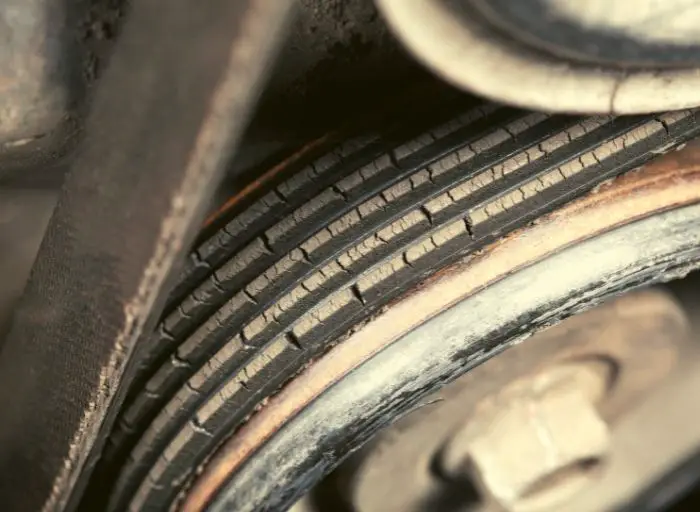
If you want to make your fan belt more modern, you can use the serpentine belt. It has many grooves inside of it for better contact and reliability, and it is also called a drive belt. A car won’t work well if the serpentine belt breaks, so what happens to a car when the serpentine belt breaks?
Simply put, if the serpentine belt is broken, there is no power help for the steering system. It will also stop the water pump from moving antifreeze through the cooling system. This means that if the serpentine belt breaks, the engine can overheat at any time.
Table of Contents
The Serpentine Belt: What Is It and What Is It Used For?
This type of belt is a single belt with many grooves inside that move around various parts to make them run in the same direction. This makes them run together. You need it to keep your car running well.
A serpentine belt drives a number of significant parts of the car, such as the alternator, power steering, water pump, or A/C compressor.
Most people think of serpentine belts as a piece of rope, but it is used to power everything in a car as well. It moves and rotates all the time as the car is going, just like it does. It sends power to all the important parts of the car, from the water pump to the air conditioning.
What Happens to a Car When the Serpentine Belt Breaks?
As time goes on, even though the serpentine belt might not even break, it wears down a little. As the belt on the engine starts to wear down, or if it gets dirty or damaged, the engine accessories can’t move at the right speed.
For example, the alternator in the engine is intended to power the car’s electrical system and recharge the battery while the car is running. When the alternator isn’t spinning fast enough, the result will go down, which can cause the battery to die. This can cause the car to run out of power, dim headlights, and other problems.
Most car manufacturers say that the serpentine belt should be checked and replaced somewhere between 60,000 and 90,000 miles. This is because new technology has made it possible to make serpentine belts that could last more than 100,000 miles.
Many parts of your car’s engine are important to how well it runs. So even though it’s not a big deal if the serpentine belt starts to break and your A/C doesn’t work, it’s a big deal if it breaks and the electrical system or the power steering doesn’t work.
Here are some of the main consequences of having a broken serpentine belt that you should know about:
- A broken serpentine belt could really cause your car to lose power steering very quickly, making it very hard to turn. A busy intersection is not the best place for this to happen when you want to make a right turn.
- Having a broken serpentine belt means that the water pump can’t move coolant through the engine’s cooling system, which makes it overheat. The belt could break at any time.
- Having a broken serpentine belt also blocks the car’s alternator from making electricity, which is needed to run both the car’s electrical and electronic systems. Besides, the belt is accountable for recharging the battery. So, if your car lights go out, the radio doesn’t work, or your dashboard lights go out, it could be that the alternator isn’t working because it has a broken belt.
Symptoms Of a Bad Serpentine Belt
It is essential to pay attention to the signs of a bad serpentine belt before this causes a lot of pain. Some cars have lights that go on when the belt is worn. Having a bad serpentine belt could well cause the following symptoms:
1. A squealing noise coming from the front of the car
This symptom is hard to ignore. Make sure your serpentine belt isn’t broken by looking for squeaks coming from the front of your car. This noise might be coming from the belt.
2. If there is a problem with the power steering and the A/C
The serpentine belt moves coolant, which is also called antifreeze, around the system. With no coolant, two of the first things that will break down are the power steering and the AC.
3. Overheating engine
Another indicator of a bad serpentine belt is when your engine gets too hot. The serpentine belt helps the car’s engine stay cool. If the belt breaks, the water pump won’t be able to run because it can’t get the power it needs from the belt. If your engine starts to overheat, get it checked out right away by a qualified mechanic. An overheating engine can cause the car to break down and cause long-term loss to the engine if it isn’t taken care of.
4. The belt has cracks or wear
You should check your serpentine belt out in person from time to time to make sure it is in great condition. Check the belt for cracks, missing pieces, or tears. Also, make sure that the belt is not too tight or too loose. If you see any of these signs, you should change your serpentine belt.
NOTE: Sometimes, the serpentine belt comes loose and doesn’t break since the tensioner and pulleys have been worn, damaged, or aren’t aligned right. Replace the belt in this case, but that won’t be enough. The problems that caused the issue or misalignment need to be fixed before the car can run properly. It can also happen that serpentine belts fall off if they aren’t routed accurately, or if it is the incorrect belt for the car.
When Should a Serpentine Belt Be Replaced?
Your owner’s manual will tell you when to change your serpentine belt. Most car manufacturers say that you should check and change your serpentine belt around 60,000 and 90,000 miles. There have been big changes in the way materials are made. Some belts can now survive more than 100k miles!
However, if the serpentine belt starts making loud noises, you know it’s time to get a new one.
You could also test the belt to see if there are tiny cracks. This will help you know when to change the belt. The belt doesn’t need to be changed right away, but small cracks are a good sign that it will need to be replaced soon.
If your belt is close to 50,000 miles, it might be in your best interest to get a new one. Also, a lot of mechanics recommend that you get a new water pump when you get your serpentine belt changed. One reason is that the parts wear out at the same time.
How much does it cost to Replace a Serpentine Belt?
Hire a mechanic to change a serpentine belt usually costs between $60 and $200. That will cost $25 to $75 for the belt and around an hour of work, which usually costs $75 to $120 an hour. It will take more time to replace a serpentine belt on some cars. People will have to spend more time getting the belt if it’s in a hard-to-reach place.
Does the Brand of Serpentine Belt Matter?
There are a lot of different types of serpentine belts out there. Most mechanics like to use the original parts since they are supposed to last longer. It’s still possible to find cheaper serpentine belts that are good.
Belts with good rubber parts are what you should look for. Good rubber will make the serpentine belt last longer and endure more wear.
In case you don’t want to try something new, just buy the factory ones.
Conclusion
You should pay close attention to the wear and tear of the serpentine belt. This is important. Getting rid of it before it does any damage will keep you and other people safe. It’s better you have your serpentine belt checked by a trusted mechanic to prevent power steering problems, overheating engines, and electrical issues.
Hi there! I’m Naomi O’Colman. I’ve got years of experience working at an auto repair shop here in Texas under my belt. On top of that, ever since I was a kid I’ve been passionate about the auto industry. Since I’ve joined the team at automotivegearz.com I’ve been enthusiastically sharing my passion and insights with my readers. I’m dedicated to delivering high quality content and helping you stay up to date with the latest automotive trends and products out there!







